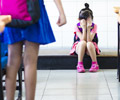For most adolescents, becoming more popular increases their risk of getting bullied and worsens the negative consequences of being victimized, a new study has found.

This does not mean that stereotypical bullying victims — kids with body image issues, delayed physical development, or those without any friends at all — are not picked on. "Socially vulnerable youth are frequently tormented and this is a huge problem," Faris said. "However, our study suggests that many victims don't fit the stereotype."
Titled, "Casualties of Social Combat: School Networks of Peer Victimization and Their Consequences," the study, which appears in the April issue of the American Sociological Review, relies on data from the Context of Adolescent Substance Use survey, a longitudinal survey of adolescents at 19 public schools in three counties in North Carolina that began in the spring of 2002. In their study, Faris and his co-author Diane Felmlee, a professor of sociology at Pennsylvania State University, focus on more than 4,200 8th, 9th, and 10th grade students who participated in the survey during the 2004-2005 school year.
The researchers determined students' popularity based on how central they were in their school's web of friendships and measured victimization by analyzing interviews in which students were asked to nominate up to five schoolmates who picked on or were mean to them and up to five peers whom they picked on or were mean to, Faris said.
Among both boys and girls, Faris said that if an adolescent is in the middle of the school social hierarchy — the 50th percentile — and moves up the social ladder to the 95th percentile, the likelihood that he or she will be victimized by his or her peers increases by more than 25 percent.
"But once students reach the very peak of the school hierarchy — above the 95th percentile — the likelihood of being victimized plummets," Faris said. "So, while the climb to the top of the social ladder can be painful, the very top rung offers a safe perch above the fray."
Advertisement
"If status were money, they would be like Bill Gates — their positions are secure," Faris said. "They don't need to torment their peers in an effort to climb up the social ladder — a tactic commonly used among those battling for position — because they are already at the top, and they aren't being victimized because they are out of reach and have no rivals."
Advertisement
"This may be because popular students feel like they have more to lose, since they may have worked quite hard to attain their social standing," Faris said. "Another possibility is that more popular students are more unsuspecting victims than those on the periphery, and therefore react particularly strongly."
Although the study focuses on a sample of small-town and rural North Carolina students, Faris thinks the findings would generally be consistent for adolescents in other places as well. In fact, Faris and Felmlee recently found similar results among students at an elite public high school in a wealthy Long Island suburb of New York City. "I certainly wouldn't say our findings are going to hold true at every single school, but I think it is a common pattern," Faris said. "I say that especially because we have found the same trend among adolescents in such different contexts."
In terms of the study's policy implications, Faris said he hopes the study raises awareness among parents, educators, and policymakers that students do not necessarily have to have obvious stigmas about them to be bullying victims.
"We hope that in addition to continuing to help socially vulnerable youth, these more central victims, hidden in plain sight, are acknowledged in the national dialogue as well," said Faris, who noted that bullying prevention programs are often focused on addressing social skill deficits, empathy shortages, and impulse control, while the root cause of much aggression is the competition for prestige.
"Status competition, however, has never been the primary focus of prevention programs," Faris said. "To reduce bullying, it may be useful for schools to dedicate more attention and resources to deemphasizing social status hierarchies, perhaps by fostering a greater diversity of activities that promote a variety of interest-based friendship groups and not celebrating one activity — such as basketball or football — over any other."
Source-Eurekalert








